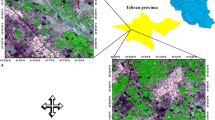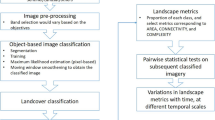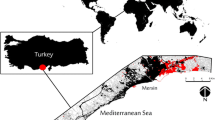Abstract
Land use and land cover changes (LULC) result in alterations to landscape structure, with particularly significant consequences in the landscapes of coastal basins due to their unique characteristics and special sensitivity. The aim of this work was to introduce a new methodology to assess the impacts of LULC transitions on landscape structure in a coastal basin of the Los Ríos Region in Chile. Changes in landscape patterns were assessed by analyzing systematic transitions in conjunction with moving windows landscape metrics and spatial cluster analysis. An index measuring the impact of transitions on landscape structure change (ITSC) was calculated to assess the degree to which each systematic transition contributed to the spatial cluster of landscape change. The proposed method showed that transitions resulting from the replacement of native forest and especially those which involve its transformation into forestry plantations, have the greatest potential impact on landscape structure in the basin. Therefore, planning and management measures must be established to prevent such transitions, so avoiding a massive change in landscape structure.





Similar content being viewed by others
References
Aburto F, Cartes E, Mardones O, Rubilar R (2021) Hillslope soil erosion and mobility in pine plantations and native deciduous forest in the coastal range of south-Central Chile. Land Degrad Dev 32(1):453–466. https://doi.org/10.1002/ldr.3700
Aguilera F, Valenzuela LM, Botequilha-Leitão A (2011) Landscape metrics in the analysis of urban land use patterns: a case study in a Spanish metropolitan area. Landsc Urban Plan 99(3–4):226–238. https://doi.org/10.1016/j.landurbplan.2010.10.004
Aguilera-Benavente F, Botequilha-Leitão A, Díaz-Varela E (2014) Detecting multi-scale urban growth patterns and processes in the algarve region (Southern Portugal). Appl Geogr 53:234–245. https://doi.org/10.1016/j.apgeog.2014.06.019
Anselin L, Li X, Koschinsky J (2021) GeoDa, from the desktop to an ecosystem for exploring spatial data. Geogr Anal. https://doi.org/10.1111/gean.12311
Arowolo AO, Deng X (2018) Land use/land cover change and statistical modelling of cultivated land change drivers in Nigeria. Reg Environ Change 18(1):247–259. https://doi.org/10.1007/s10113-017-1186-5
Bonilla-Bedoya S, Molina JR, Macedo-Pezzopane JE, Herrera-Machuca MA (2014) Fragmentation patterns and systematic transitions of the forested landscape in the upper Amazon region, ecuador 1990–2008. J for Res 25(2):301–309. https://doi.org/10.1007/s11676-013-0419-9
Botequilha Leitão A, Ahern J (2002) Applying landscape ecological concepts and metrics in sustainable landscape planning. Landsc Urban Plan 59(2):65–93. https://doi.org/10.1016/S0169-2046(02)00005-1
Botequilha-Leitão A, Diáz-Varela E (2018) An alternative planning paradigm for coastal landscapes and tourism Spatial metrics as indicators for planning coastal tourism landscapes. Tour Manag Stud 14(1):45–57. https://doi.org/10.18089/tms.2018.14104
Chavez PS (1996) Image-based atmospheric corrections—revisited and improved. Photogramm Eng Remote Sens 62:1025–1035
Cushman SA, Landguth EL (2010) Scale dependent inference in landscape genetics. Landscape Ecol 25(6):967–979. https://doi.org/10.1007/s10980-010-9467-0
Cushman SA, McGarigal K, Neel MC (2008) Parsimony in landscape metrics: strength, universality, and consistency. Ecol Ind 8(5):691–703. https://doi.org/10.1016/j.ecolind.2007.12.002
Di Castri F, Hajek ER (1976). Bioclimatología de chile (Vol. 128). Vicerrectoría Académica de la Universidad Católica de Chile Santiago
Díaz-Varela E, Álvarez-López CJ, Marey-Pérez MF (2009) Multiscale delineation of landscape planning units based on spatial variation of land-use patterns in Galicia. NW Spain Landsc Ecol Eng 5(1):1–10. https://doi.org/10.1007/s11355-008-0053-4
Diaz-Varela E, Roces-Díaz JV, Álvarez-Álvarez P (2016) Detection of landscape heterogeneity at multiple scales: use of the quadratic entropy index. Landsc Urban Plan 153:149–159. https://doi.org/10.1016/j.landurbplan.2016.05.004
Duarte GT, Santos PM, Cornelissen TG, Ribeiro MC, Paglia AP (2018) The effects of landscape patterns on ecosystem services: meta-analyses of landscape services. Landscape Ecol 33(8):1247–1257. https://doi.org/10.1007/s10980-018-0673-5
Ducci L, Agnelli P, Di Febbraro M, Frate L, Russo D, Loy A, Roscioni F (2015) Different bat guilds perceive their habitat in different ways: a multiscale landscape approach for variable selection in species distribution modelling. Landscape Ecol 30:2147–2159. https://doi.org/10.1007/s10980-015-0237-x
Echeverria C, Coomes D, Salas J, Rey-Benayas JM, Lara A, Newton A (2006) Rapid deforestation and fragmentation of chilean temperate forests. Biol Cons 130(4):481–494. https://doi.org/10.1016/j.biocon.2006.01.017
Foody GM (2008) Harshness in image classification accuracy assessment. Int J Remote Sens 29(11):3137–3158. https://doi.org/10.1080/01431160701442120
Frazier AE, Kedron P (2017) Landscape metrics: past progress and future directions. Curr Landsc Ecol Rep 2(3):63–72. https://doi.org/10.1007/s40823-017-0026-0
Galletti CS, Turner BL, Myint SW (2016) Land changes and their drivers in the cloud forest and coastal zone of Dhofar, Oman, between 1988 and 2013. Reg Environ Change 16(7):2141–2153. https://doi.org/10.1007/s10113-016-0942-2
García-Llamas P, Geijzendorffer IR, García-Nieto AP, Calvo L, Suárez-Seoane S, Cramer W (2019) Impact of land cover change on ecosystem service supply in mountain systems: a case study in the cantabrian mountains (NW of Spain). Reg Environ Change 19(2):529–542. https://doi.org/10.1007/s10113-018-1419-2
Grimm NB, Faeth SH, Golubiewski NE, Redman CL, Wu J, Bai X, Briggs JM (2008) Global change and the ecology of cities. Science 319(5864):756–760. https://doi.org/10.1126/science.1150195
Hagen-Zanker A (2016) A computational framework for generalized moving windows and its application to landscape pattern analysis. Int J Appl Earth Obs Geoinf 44:205–216. https://doi.org/10.1016/j.jag.2015.09.010
Hermann A, Schleifer S, Wrbka T (2011) The concept of ecosystem services regarding landscape research: a review. Living Rev Landsc Res. https://doi.org/10.12942/lrlr-2011-1
Hermosilla-Palma K, Pliscoff P, Folchi M (2021) Sixty years of land-use and land-cover change dynamics in a global biodiversity hotspot under threat from global change. J Land Use Sci 16(5–6):467–478. https://doi.org/10.1080/1747423X.2021.2011970
Lara A, Little C, Urrutia R, McPhee J, Álvarez-Garretón C, Oyarzún C, Soto D, Donoso P, Nahuelhual L, Pino M, Arismendi I (2009) Assessment of ecosystem services as an opportunity for the conservation and management of native forests in Chile. For Ecol Manage 258(4):415–424. https://doi.org/10.1016/j.foreco.2009.01.004
Lausch A, Blaschke T, Haase D, Herzog F, Syrbe R-U, Tischendorf L, Walz U (2015) Understanding and quantifying landscape structure – a review on relevant process characteristics, data models and landscape metrics. Ecol Model 295:31–41. https://doi.org/10.1016/j.ecolmodel.2014.08.018
Lebdioui A (2019) Chile’s export diversification since 1960: a free market ? Dev Chang 50(6):1624–1663. https://doi.org/10.1111/dech.12545
Lv J, Ma T, Dong Z, Yao Y, Yuan Z (2018) Temporal and spatial analyses of the landscape pattern of Wuhan city based on remote sensing images. ISPRS Int J Geo Inf 7(9):340. https://doi.org/10.3390/ijgi7090340
Miranda A, Altamirano A, Cayuela L, Lara A, González M (2017) Native forest loss in the Chilean biodiversity hotspot: revealing the evidence. Reg Environ Change 17(1):285–297. https://doi.org/10.1007/s10113-016-1010-7
Peña-Cortés F, Escalona M, Soria-Lara JA, Pincheira-Ulbrich J, Salinas-Silva C, Alarcón F (2020) Translating sociocultural transformations into historical maps on land use changes: the case of Lafkenmapu (Araucanía, Chile). J Maps 16(1):163–171. https://doi.org/10.1080/17445647.2020.1793817
Peña-Cortés F, Vergara-Fernández C, Pincheira-Ulbrich J, Aguilera-Benavente F, Gallardo-Alvarez N (2021) Location factors and dynamics of tree plantation expansion in two coastal river basins in south-central Chile: basis for land use planning. J Land Use Sci 16(2):159–173. https://doi.org/10.1080/1747423X.2021.1882597
Peña-Cortés F, Rebolledo G, Hermosilla K, Hauenstein E, Bertrán C, Schlatter R, Tapia J (2006). Dinámica del paisaje para el período 1980–2004 en la cuenca costera del Lago Budi, Chile. Consideraciones para la conservación de sus humedales. Ecología Austral, 14
Peña-Cortés F, Pincheira-Ulbrich J, Fernández-Soto G, Rebolledo E, Andrade C, Salinas (2019) Ordenamiento territorial en Chile: desafíos para incorporar la gestión integrada de zonas costeras. In: En C, Martínez R, Hidalgo C, Henríquez F, Arenas N, Rangel-Buitrago M, Contreras-López (Eds), La zona costera en Chile: Adaptación y planificación para la residencia. Serie GEOlibros Nº 31 Instituto de Geografía PUC, Santiago, Chile, pp. 353-396. Available in: https://geografia.uc.cl/destacados/1877-se-publica-nuevo-geolibro-la-zona-costeraen-chile-adaptacion-y-planificacion-para-la-resiliencia
Pontius RG, Shusas E, McEachern M (2004) Detecting important categorical land changes while accounting for persistence. Agr Ecosyst Environ 101(2–3):251–268. https://doi.org/10.1016/j.agee.2003.09.008
Rey Benayas JM, Altamirano A, Miranda A, Catalán G, Prado M, Lisón F, Bullock JM (2020) Landscape restoration in a mixed agricultural-forest catchment: planning a buffer strip and hedgerow network in a Chilean biodiversity hotspot. Ambio 49(1):310–323. https://doi.org/10.1007/s13280-019-01149-2
Rodríguez-Espinosa VM, Aguilera-Benavente F, Gómez-Delgado M (2019) Green infrastructure design using GIS and spatial analysis: a proposal for the Henares Corridor (Madrid-Guadalajara, Spain). Landsc Res 45(1):26–43. https://doi.org/10.1080/01426397.2019.1569221
Song X-P, Hansen MC, Stehman SV, Potapov PV, Tyukavina A, Vermote EF, Townshend JR (2018) Global land change from 1982 to 2016. Nature 560(7720):639–643. https://doi.org/10.1038/s41586-018-0411-9
Soria-Lara JA, Aguilera-Benavente F, Arranz-López A (2016) Integrating land use and transport practice through spatial metrics. Transportation Res Part a: Policy Pract 91:330–345. https://doi.org/10.1016/j.tra.2016.06.023
Tudi M, Daniel Ruan H, Wang L, Lyu J, Sadler R, Connell D, Chu C, Phung DT (2021) Agriculture development, pesticide application and its impact on the environment. Int J Environ Res Public Health 18(3):1112. https://doi.org/10.3390/ijerph18031112
Wang R, Feng Y, Tong X, Zhao J, Zhai S (2021) Impacts of spatial scale on the delineation of spatiotemporal urban expansion. Ecol Indicators 129:107896. https://doi.org/10.1016/j.ecolind.2021.107896
Wu J, Jenerette GD, Buyantuyev A, Redman CL (2011) Quantifying spatiotemporal patterns of urbanization: the case of the two fastest growing metropolitan regions in the United States. Ecol Complex 8(1):1–8. https://doi.org/10.1016/j.ecocom.2010.03.002
Zamorano-Elgueta C, Rey Benayas JM, Cayuela L, Hantson S, Armenteras D (2015) Native forest replacement by exotic plantations in southern Chile (1985–2011) and partial compensation by natural regeneration. For Ecol Manage 345:10–20. https://doi.org/10.1016/j.foreco.2015.02.025
Acknowledgements
This work was supported by the “Estímulo a la Excelencia para Profesores Universitarios Permanentes” research programme funded by the University of Alcalá and the Regional Government of Madrid [grant number EPU-INV/2020/009] and “Repensando el Ordenamiento Territorial en Chile: Perspectivas críticas, conocimiento local/mapuche y escenarios co-construidos para la toma de decisiones sostenibles”. FONDECYT [grant number 1221931] of National Research and Development Agency, ANID.
Funding
This study was supported by Comunidad de Madrid, [Grant Number EPU-INV/2020/009], Francisco Aguilera-Benavente, Chilean National Agency for Research and Development, FONDECYT [Grant Number 1221931], Fernando Peña-Cortés.
Author information
Authors and Affiliations
Corresponding author
Ethics declarations
Conflicts of interest
No potential conflicts of interest were reported by the authors.
Supplementary Information
Below is the link to the electronic supplementary material.
Rights and permissions
Springer Nature or its licensor (e.g. a society or other partner) holds exclusive rights to this article under a publishing agreement with the author(s) or other rightsholder(s); author self-archiving of the accepted manuscript version of this article is solely governed by the terms of such publishing agreement and applicable law.
About this article
Cite this article
Aguilera-Benavente, F., Vergara-Fernández, C., Rebolledo-Castro, G. et al. A new methodology to quantify structural landscape impacts of land use/land cover change using moving window metrics: a case study in a Chilean coastal basin. Landscape Ecol Eng 19, 673–686 (2023). https://doi.org/10.1007/s11355-023-00572-8
Received:
Revised:
Accepted:
Published:
Issue Date:
DOI: https://doi.org/10.1007/s11355-023-00572-8




